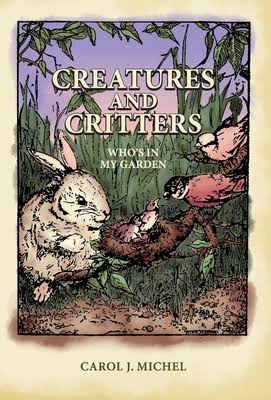Strangers in My Garden
By George Graine, Fairfax Master Gardener
“While trees are excellent for apes, owls, and arboreal fauna in general, they are annoying in a small garden where one hopes for something besides a compost pile and a continental championship collection of slugs and sow bugs.” — Henry Mitchell (1923-1993)
 “You are never alone in your garden,” writes Carol J. Michel in her latest book, “Creatures and Critters: Who’s in My Garden” (Gardenangelist Books, 2020). Take a fanciful trip through your own zoological garden. Here you will be guaranteed to meet numerous creatures and critters very much like those described by Michel. Most likely, you will then not see your garden in the same way again, because now you know that something is lurking in your garden. (Cue spooky music or something delightful.) Is it something good or otherwise? Some you will see and some are not visible, at least at the moment you are looking. As Michel writes, “… stuff is real even when we can’t see it.”
“You are never alone in your garden,” writes Carol J. Michel in her latest book, “Creatures and Critters: Who’s in My Garden” (Gardenangelist Books, 2020). Take a fanciful trip through your own zoological garden. Here you will be guaranteed to meet numerous creatures and critters very much like those described by Michel. Most likely, you will then not see your garden in the same way again, because now you know that something is lurking in your garden. (Cue spooky music or something delightful.) Is it something good or otherwise? Some you will see and some are not visible, at least at the moment you are looking. As Michel writes, “… stuff is real even when we can’t see it.”
Perhaps it is best to start your read with the last chapter called “The Gardener.” This is like an ah-ha! moment because the author explains that we are “… the most important creature in the garden.” Who among us would take issue with that? You do all of the composting, weeding, planting, harvesting and anything else that needs doing. Allan Armitage (aka Dr. A), the distinguished horticulturist, noted that the worst oxymoron in all of horticulture is Serious Gardener. Furthermore, he stated, “If one wants to see the demise of gardening, keep making it complicated.”
The book’s table of contents includes 25 chapters all packed into 141 pages. That includes a lot of denizens to consider and cope with. Some are good, some not so much and some will give you pause. It is not an error to find that bees and butterflies do not have their own chapter. In fact, Michel firmly recognizes their worth in the last chapter, so forgive her as this is truly not an oversight. Many other creatures and critters are not included probably due to space limitations. Some may be your favorites, such as hummingbirds, praying mantises, turtles and dragonflies and others not so much, like voles, ants, cicadas and snakes.
It is interesting to note that three chapters are all about the second most important creature. As the gardener, you are #1. These are the Garden Fairies, and you can read about them in three different chapters: the beginning, middle and end of the book. To be sure, Garden Fairies are not a myth. They exist if only as an abstraction, and they are a powerful lot. Garden Fairies are for real! In simplest terms, Garden Fairies can help you to garden more efficiently because they are a powerful force. They have the ability of three E’s, that is, elucidate, educate and enthuse you. Also note that Garden Fairies do not necessarily follow garden rules. Things happen in the garden, and they tend to operate using the KISS principle of Keep It Simple Stupid.
According to Michel, you are on top of the food chain in your own garden. But note that you are but a guest there because all of the creatures and critters have been in the garden long before you took up residence. For example, consider the dinosaurs. Surely there is a place for an old dino. Wouldn’t he make an ideal gift for those with a quirky paleontology bent? Perhaps something more up-to-date like a gorilla is more your style. Would any of these and others in the book such as rabbits, squirrels, chipmunks, owls and many more be better than having Saint Fiacre, the garden saint for gardeners? Surely, they would be more memorable, if unexpected and more startling. Just think about the conversations you could have so that you could ignore the poorly shaped and forlorn, expensive, fanciful, sculptured conifer. Here is another thought considered by Michel that makes perfectly good sense. Have a big, grey elephant in your garden. What would be better used to hide one of those ugly utility boxes that was plopped down on your property?
And so, by now, you should have gotten the idea that “Creatures and Critters” is a hoot (pardon the pun). Be prepared to see yourself and wonder sometimes what you are doing in the garden. To be sure, you will be amused and even comforted to read a book with mirth and helpful hints AND at the same time provide sound gardening advice with many options. You will become educated, but not confused all at the same time.
Thank you, Garden Fairies!